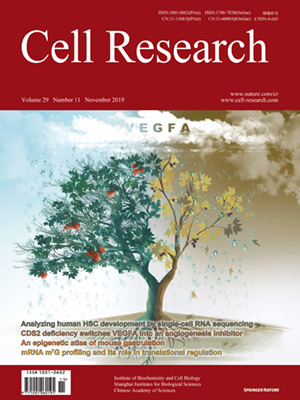
Volume 29, No 11, Nov 2019
ISSN: 1001-0602
EISSN: 1748-7838 2018
impact factor 17.848*
(Clarivate Analytics, 2019)
Volume 29 Issue 11, November 2019: 911-926
ORIGINAL ARTICLES
Distinct enhancer signatures in the mouse gastrula delineate progressive cell fate continuum during embryo development
Xianfa Yang1, Boqiang Hu2, Jiaoyang Liao1, Yunbo Qiao3, Yingying Chen 1, Yun Qian1, Su Feng1, Fang Yu1, Ji Dong2, Yu Hou2, He Xu1,Ran Wang1, Guangdun Peng 1,4,5,6, Jinsong Li 1,7, Fuchou Tang 2,8,9 and Naihe Jing 1,6,7
1 State Key Laboratory of Cell Biology, CAS Center for Excellence in Molecular Cell Science, Shanghai Institute of Biochemistry and Cell Biology, Chinese Academy of Sciences,University of Chinese Academy of Sciences, 200031 Shanghai, China; 2Beijing Advanced Innovation Center for Genomics, College of Life Sciences, Peking University, 100871 Beijing, China; 3Precise Genome Engineering Center, School of Life Sciences, Guangzhou University, Guangzhou 510006 Guangdong, China; 4CAS Key Laboratory of Regenerative Biology and Guangdong Provincial Key Laboratory of Stem Cell and Regenerative Medicine, Guangzhou Institutes of Biomedicine and Health, Chinese Academy of Sciences, Guangzhou 510530 Guangdong, China; 5Guangzhou Regenerative Medicine and Health Guangdong Laboratory (GRMH-GDL), Guangzhou 510005 Guangdong, China; 6Institute for Stem Cell and Regeneration, Chinese Academy of Sciences, 100101 Beijing, China; 7School of Life Science and Technology, ShanghaiTech University, 201210 Shanghai, China; 8Ministry of Education Key Laboratory of Cell Proliferation and Differentiation, 100871 Beijing, China and 9Peking-Tsinghua Center for Life Sciences, Peking University, 100871 Beijing, China
Correspondence: Yunbo Qiao (ybqiao@gzhu.edu.cn) or Jinsong Li (jsli@sibcb.ac.cn) or Fuchou Tang (tangfuchou@pku.edu.cn) or Naihe Jing (njing@sibcb.ac.cn)These authors contributed equally: Xianfa Yang, Boqiang Hu, Jiaoyang Liao, Yunbo Qiao
Primary germ layers have the potential to form all tissues in the mature organism, and their formation during gastrulation requires precise epigenetic modulation of both proximal and distal regulatory elements. Previous studies indicated that spatial and temporal patterns of gene expression in the gastrula predispose individual regions to distinct cell fates. However, the underlying epigenetic mechanisms remain largely unexplored. Here, we profile the spatiotemporal landscape of the epigenome and transcriptome of the mouse gastrula. We reveal the asynchronous dynamics of proximal chromatin states during germ layer formation as well as unique gastrula-specific epigenomic features of regulatory elements, which have strong usage turnover dynamics and clear germ layer-specific signatures. Importantly, we also find that enhancers around organogenetic genes, which are weakly expressed at the gastrulation stage, are frequently pre-marked by histone H3 lysine 27 acetylation (H3K27ac) in the gastrula. By using the transgenic mice and genome editing system, we demonstrate that a pre-marked enhancer, which is located in the intron of a brain-specific gene 2510009E07Rik, exhibits specific enhancer activity in the ectoderm and future brain tissue, and also executes important function during mouse neural differentiation. Taken together, our study provides the comprehensive epigenetic information for embryonic patterning during mouse gastrulation, demonstrates the importance of gastrula pre-marked enhancers in regulating the correct development of the mouse embryo, and thus broadens the current understanding of mammalian embryonic development and related diseases.
https://doi.org/10.1038/s41422-019-0234-8
FULL TEXT | PDF
Browse 1179


